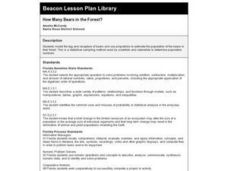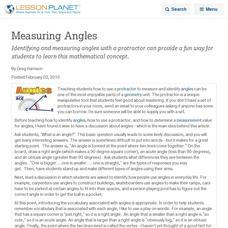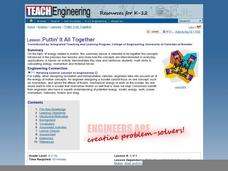Curated OER
IS A BLUE WHALE THE BIGGEST THING THERE IS?
First graders explore measurement in relation to size of objects.
Curated OER
How Many Bears in the Forest?
Third graders model the tag and recapture of bears and use proportions to estimate the population of the bears in their forest. This is a statistical sampling method used by scientists and naturalists to determine population numbers.
Curated OER
The Fourth Quadrant of Proportiona
Students experiment with scale to solve a problem presented in a video clip. They determine the correct size to use when constructing a model and evaluate the use of proportions in real life applications.
Curated OER
Properties of Fractals
Young scholars build a working definition of a regular fractal, they measure the concepts of dimensions and scale, they explore the concept of a logarithm and they attempt to solve simple exponential equations for the exponent both by...
Curated OER
All About Me
Third graders investigate the use of centimeters while measuring items with rulers which they construct. They examine the need for standard units of measure. They estimate the length of body parts before making the actual measurements.
Curated OER
Sports and Geometry
Pupils investigate shapes in sports. In this geometry activity, students identify geometric shapes in sports equipment, fields, etc. Pupils present their findings.
Curated OER
Measuring Angles
Identifying and measuring angles with a protractor can provide a fun way for students to learn this mathematical concept.
Curated OER
Analyzing 3-D Shapes and 2-D Representations
Students can analyze 3-D objects better with actual physical models and by also drawing 2-D representations of them.
Curated OER
Puttin' It All Together
Pupils explain the concepts of kinetic and potential energy and how it can change forms. In this energy, motion, and frictional forces instructional activity students participate in a hands on activity that includes calculating energy.
Curated OER
TAKS Quiz-Confusing Words
In this TAKS quiz worksheet, students take an online quiz focused on confusing words. Quiz may be graded online by clicking a link.
Curated OER
Cinco de Mayo Lessons with "La Vida"
Cinco de Mayo lessons provide a way to teach students about history, art, music, and regional food.
Curated OER
Eggs'ceptional Experiments
Young scholars see evidence of chemical reaction and follow the scientific method to hypothesize, observe, and reach conclusions. They conduct a series of egg based experiments such as forming crystals and complete journal activities as...
Curated OER
Create a Community that Promotes Academic Language
Set your elementary, middle, and high schoolers up for success by implementing a variety of strategies to build academic language.
Curated OER
Define Geometry Terms
The Common Core is intended to help all children meet high academic standards. Here is a Common Core designed lesson that is intended for learners with communication or language difficulties. The lesson is written in a narrative style...
Teach Engineering
Exploring Energy: Kinetic and Potential
The potential of the energy in the class is moving. The third segment in a six-part unit on energy provides a deeper understanding of kinetic and potential energy. Learners understand the relationship between mass, speed, and energy and...
Curated OER
"Old 300"
Fourth graders combine art and history to assess the importance of the "Old 300." They explore a group of colonists that Stephen F. Austin brought to Texas as the first settlers and then create a time line of major events leading to the...
Smithsonian Institution
What's the Code? Coding Robot Movements Using Sound
Tap into the desire to learn about computer codes. Pupils apply the Tap Code and the Polybius Square to send secret codes using sound. They design a code that tells a robot what movements to make and then test out their code using one of...
Teach Engineering
Density Column Lab - Part 1
Mass and density — aren't they the same thing? This activity has groups use balance beams and water displacement to measure several objects. The pupils use the measurements to calculate the density of the objects.
Curated OER
America's Pastime
Young scholars relate Newton's Laws of Motion to the game of baseball. They compare and contrast the materials used in baseballs that could affect their performance. They also determine how friction can be increased or decreased in a...
Curated OER
Parachutes: What a Drag
Sixth graders make 2 different kinds of parachutes and record and graph the time for each one for the different drag forces. In this parachute lesson plan, 6th graders compare the results to the rest of the class of each parachute and...
Curated OER
Industrial Revolution in America: Exploring the Effects of the Heat Engine on the Growth of Cities
Students research the development of the steam engines. In this US history lesson, students analyze the impact of this invention to civilization. They discuss the events leading to the growth and development of different cities.
Curated OER
Industrial Revolution in America: Exploring the Effects of the Heat Engine on the Growth of Cities
Eighth graders examine the reasons for the growth of cities in North American. Using the internet, they research the causes and effects of the Industrial Revolution and determine if the growth of cities is a sign of progress. They...
Curated OER
Fossils Footprints Across Time
Students examine fossils to understand how they are formed and how they give information about geological history. In this fossil activity, students research and write about fossils and make models of different fossil types.The PDF...
Alabama Learning Exchange
Simple Machines
Students watch a video and play a game. For this simple machines lesson, students watch a video on simple machines. They play an interactive game on the Edheads web site and share what they have learned. Throughout the day students...

























